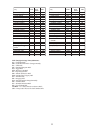
Enabling or Disabling the Wind Alerts
In the Wind Mode press the ALARM/CHART to recall a current wind speed, a wind speed alert with the “ALARM HI”
displayed or gust alert with the “GUST ALARM HI” displayed.
If the alert is disabled, “OFF” will be displayed; otherwise the alert value is shown.
When a wind alert is displayed, press the UP ? or DOWN ? to activate or deactivate it.
Wind Alerts programming
• In the Wind Mode, press ALARM/CHART to select the desired alarm.
• Press and hold ALARM/CHART button until alert and corresponding icon will flash.
• Set the alert using the UP ? or DOWN?? . Press and hold either button for fast digits advance.
• Press ALARM/CHART to confirm your selection and return to the wind alert selection screen.
Disabling the Wind Alert
To disable wind alert press ALARM/CHART.
MAINTENANCE
Changing Batteries
The battery status of each weather sensor is checked every hour. If the low battery indicator lights up, replace the batteries in the
corresponding unit.
Changing Batteries in the Main Unit
• First connect the AC/DC adaptor provided to the main unit to avoid losing any data.
• Remove the battery compartment door on the back and replace all batteries. Do not mix old and new batteries.
• Replace the battery compartment door.
Changing Batteries in Remote Weather Sensors
• Replace the batteries following the setup instructions for the corresponding sensor.
• When the batteries are properly installed, the remote weather sensor will resume sending signals to the main unit.
• To enforce an immediate remote signals search, press and hold DOWN ? on the main unit.
Cleaning
The main unit and outer casings of the remote weather sensors can be cleaned with a damp cloth. Small parts can be cleaned
with a cotton tip or pipe-cleaner.
Never use any abrasive cleaning agents and solvents. Do not immerse any units with electronic parts in water or under running
water.
Anemometer
Check if the wind vane and wind cups can spin freely and are free from dirt, debris and spider webs.
Rain Gauge
Checking and cleaning the rain sensor in a timely manner will maintain an accuracy of the precipitation measurements.
• Detach the protective screen and lid.
• Clean with soapy water and a damp cloth, removing dirt, leaves or debris
• Clean small holes and parts with Q-tips or pipe-cleaner.
• Watch out for spiders or insects that might have crawled into the funnel.
• Clean the swinging mechanism with a damp cloth.
TROUBLESHOOTING
Q: “The display shows dashes “- - -” for weather parameter(s)”
A: The display will show “- - -” when the wireless connection with the remote sensor is lost for the following periods:
Thermo-Hygrometer: 15 minutes
UV Sensor: 30 minutes
Anemometer (Wind Sensor):15 minutes
Rain Gauge (Rain Sensor):30 minutes
Check or replace the batteries for the corresponding sensor. Then press and hold DOWN ? on the main unit or handheld remote
to enforce a search for all remote signals.
If this does not work, check the wireless transmission path from the corresponding weather sensor to the main unit and change
their locations if necessary.
Although wireless signals can pass through solid objects and walls, the weather sensor should ideally be within the line of sight
of the main unit.
The following may be the cause of reception problems:
• The remote weather sensor and a main unit are too far from each other.
• The signal shielding materials, such as metal surfaces, concrete walls or dense vegetation, are in the path of transmission.
• There is interference from the wireless devices (such as cordless phones, radio headsets and baby listening devices) and
electronic appliances.
Q: “The weather readings on my weather station are different from the TV, radio or official weather reports.”
A: The weather data may vary considerably due to different environmental conditions and placement of the weather sensors.
Check the placement tips included in this manual to site your weather sensors in the best possible way.
Q: “The weather forecast is inaccurate.”
A: The weather forecast predicts the weather for the next 12 to 24 hours, and does not reflect current weather conditions.
19


















